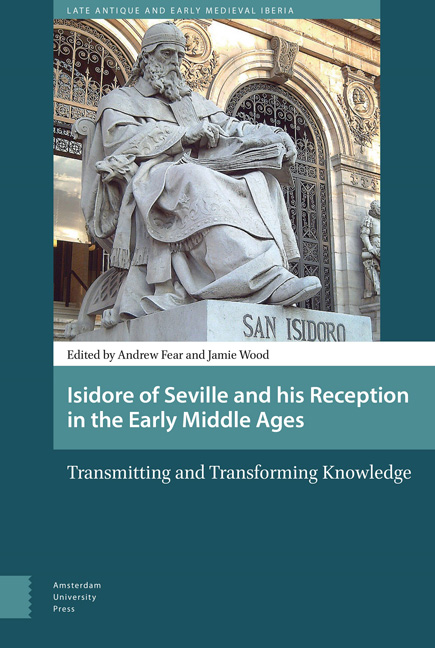 Isidore of Seville and his Reception in the Early Middle Ages
Isidore of Seville and his Reception in the Early Middle Ages Book contents
- Frontmatter
- Contents
- Preface: Paul Fouracre, University of Manchester
- 1 Introduction
- 2 A Family Affair: Leander, Isidore and the Legacy of Gregory the Great in Spain
- 3 Variations on a Theme: Isidore and Pliny on Human and Human-Instigated Anomaly
- 4 Putting the Pieces Back Together: Isidore and De Natura Rerum
- 5 The Politics of History-Writing: Problematizing the Historiographical Origins of Isidore of Seville in Early Medieval Hispania
- 6 Isidorian Texts in Seventh-Century Ireland
- 7 Isidore of Seville in Anglo-Saxon England: The Synonyma as a Source of Felix’s Vita S. Guthlaci
- 8 Hispania et Italia: Paul the Deacon, Isidore, and the Lombards
- 9 Rylands MS Latin 12: A Carolingian Example of Isidore’s Reception into the Patristic Canon
- 10 Adoption, Adaptation, & Authority: The Use of Isidore in the Opus Caroli
- Abbreviations
- Index
5 - The Politics of History-Writing: Problematizing the Historiographical Origins of Isidore of Seville in Early Medieval Hispania
Published online by Cambridge University Press: 12 December 2020
- Frontmatter
- Contents
- Preface: Paul Fouracre, University of Manchester
- 1 Introduction
- 2 A Family Affair: Leander, Isidore and the Legacy of Gregory the Great in Spain
- 3 Variations on a Theme: Isidore and Pliny on Human and Human-Instigated Anomaly
- 4 Putting the Pieces Back Together: Isidore and De Natura Rerum
- 5 The Politics of History-Writing: Problematizing the Historiographical Origins of Isidore of Seville in Early Medieval Hispania
- 6 Isidorian Texts in Seventh-Century Ireland
- 7 Isidore of Seville in Anglo-Saxon England: The Synonyma as a Source of Felix’s Vita S. Guthlaci
- 8 Hispania et Italia: Paul the Deacon, Isidore, and the Lombards
- 9 Rylands MS Latin 12: A Carolingian Example of Isidore’s Reception into the Patristic Canon
- 10 Adoption, Adaptation, & Authority: The Use of Isidore in the Opus Caroli
- Abbreviations
- Index
Summary
Introduction
In a volume dedicated to exposing and critically exploring the reception of Isidore of Seville (c. 560-636 AD) and the complicated historiography about him, what this chapter will do is take the reader back to the very origins of the historical memory of Isidore. It began in the year 636, in Seville, when the illustrious bishop died and the first historical representation of him was produced. This was followed by several other representations from writers around Hispania. The intention of this chapter is not only to introduce the reader to the inception of the written memory of Isidore, but also to problematize the natures of these first-generation historical representations. In so doing, the author shows that the long historiography on Isidore began as competing constellations for the memory of Isidore. There was never in pre-Islamic Iberia, a singular representation of Isidore or agreement about the meaning and extent of his works or the significance of his life. The differing accounts illustrate the vigor that history-writing played in the fierce struggles for authority endemic to early medieval Hispania. They also demonstrate that any comprehensive account of the reception of Isidore must begin by showing the disagreements that characterized the original historiography of Isidore, which was displaced in the generations after his death and outside his network and kingdom.
First-Generation Historical Representations
There are four first-generation representations and historical accounts of Isidore. The first is the praise obituary known as the Obitus Beati Isidori written by Redemptus, a cleric at or near Seville. The text is from 636 and is preserved in a problematic eighth-century manuscript at El Escorial (R.II.14). The second account of Isidore is Braulio of Saragossa's (590-651), Renotatio Isidori a Braulione Caesaraugustano episcopo edita (Renotatio), added to Isidore's De Viris Illustribus (DVI), and three of his letters (Epistolae), all of which are preserved in the ninth-century Toledan-Cordoban manuscript, León Cathedral 22 (c. 830-839). All that can be said of the dating of the Renotatio is that it was written before Braulio's death in 651. The forty-four letters in the collection were written over the course of two decades and include letters to and from Isidore.
- Type
- Chapter
- Information
- Isidore of Seville and his Reception in the Early Middle AgesTransmitting and Transforming Knowledge, pp. 93 - 110Publisher: Amsterdam University PressPrint publication year: 2016
- 1
- Cited by


